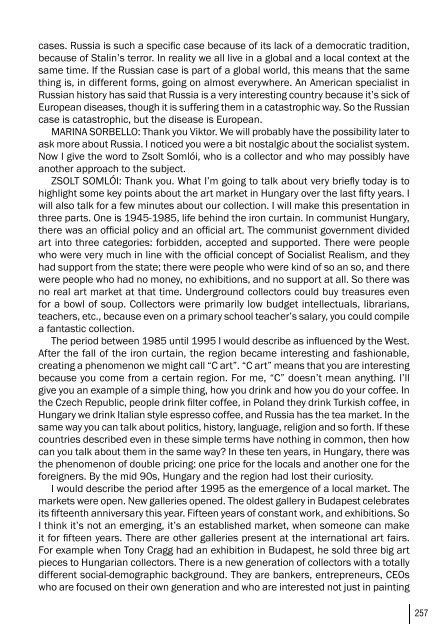art-e-conomy _ reader - marko stamenkovic
art-e-conomy _ reader - marko stamenkovic
art-e-conomy _ reader - marko stamenkovic
Create successful ePaper yourself
Turn your PDF publications into a flip-book with our unique Google optimized e-Paper software.
cases. Russia is such a specific case because of its lack of a democratic tradition,<br />
because of Stalin’s terror. In reality we all live in a global and a local context at the<br />
same time. If the Russian case is p<strong>art</strong> of a global world, this means that the same<br />
thing is, in different forms, going on almost everywhere. An American specialist in<br />
Russian history has said that Russia is a very interesting country because it’s sick of<br />
European diseases, though it is suffering them in a catastrophic way. So the Russian<br />
case is catastrophic, but the disease is European.<br />
MARINA SORBELLO: Thank you Viktor. We will probably have the possibility later to<br />
ask more about Russia. I noticed you were a bit nostalgic about the socialist system.<br />
Now I give the word to Zsolt Somlói, who is a collector and who may possibly have<br />
another approach to the subject.<br />
ZSOLT SOMLÓI: Thank you. What I’m going to talk about very briefly today is to<br />
highlight some key points about the <strong>art</strong> market in Hungary over the last fifty years. I<br />
will also talk for a few minutes about our collection. I will make this presentation in<br />
three p<strong>art</strong>s. One is 1945-1985, life behind the iron curtain. In communist Hungary,<br />
there was an official policy and an official <strong>art</strong>. The communist government divided<br />
<strong>art</strong> into three categories: forbidden, accepted and supported. There were people<br />
who were very much in line with the official concept of Socialist Realism, and they<br />
had support from the state; there were people who were kind of so an so, and there<br />
were people who had no money, no exhibitions, and no support at all. So there was<br />
no real <strong>art</strong> market at that time. Underground collectors could buy treasures even<br />
for a bowl of soup. Collectors were primarily low budget intellectuals, librarians,<br />
teachers, etc., because even on a primary school teacher’s salary, you could compile<br />
a fantastic collection.<br />
The period between 1985 until 1995 I would describe as influenced by the West.<br />
After the fall of the iron curtain, the region became interesting and fashionable,<br />
creating a phenomenon we might call “C <strong>art</strong>”. “C <strong>art</strong>” means that you are interesting<br />
because you come from a certain region. For me, “C” doesn’t mean anything. I’ll<br />
give you an example of a simple thing, how you drink and how you do your coffee. In<br />
the Czech Republic, people drink filter coffee, in Poland they drink Turkish coffee, in<br />
Hungary we drink Italian style espresso coffee, and Russia has the tea market. In the<br />
same way you can talk about politics, history, language, religion and so forth. If these<br />
countries described even in these simple terms have nothing in common, then how<br />
can you talk about them in the same way? In these ten years, in Hungary, there was<br />
the phenomenon of double pricing: one price for the locals and another one for the<br />
foreigners. By the mid 90s, Hungary and the region had lost their curiosity.<br />
I would describe the period after 1995 as the emergence of a local market. The<br />
markets were open. New galleries opened. The oldest gallery in Budapest celebrates<br />
its fifteenth anniversary this year. Fifteen years of constant work, and exhibitions. So<br />
I think it’s not an emerging, it’s an established market, when someone can make<br />
it for fifteen years. There are other galleries present at the international <strong>art</strong> fairs.<br />
For example when Tony Cragg had an exhibition in Budapest, he sold three big <strong>art</strong><br />
pieces to Hungarian collectors. There is a new generation of collectors with a totally<br />
different social-demographic background. They are bankers, entrepreneurs, CEOs<br />
who are focused on their own generation and who are interested not just in painting<br />
257


